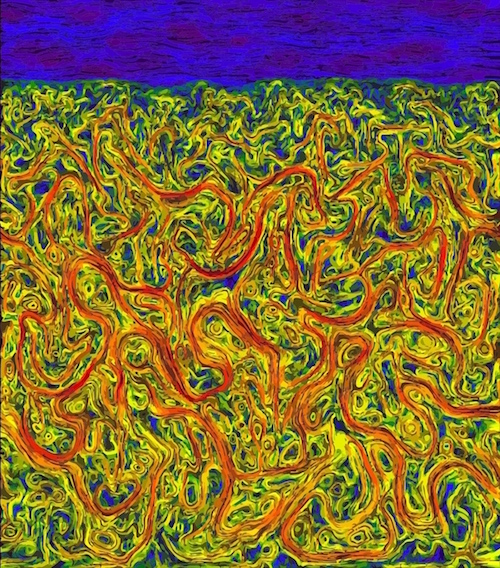Van Gogh's Ocean
First Place Winner in 2016 Art of Science Competition
The interaction between shocks and turbulence can amplify the magnetic fields by compressing and/or stretching, which may help to explain the existence of magnetic fields in the interstellar medium and outskirts of the intracluster medium.
This picture, exhibiting the magnetic field in the shocked region of the interstellar medium due to supernovae explosion, is produced from a high-resolution MHD simulation and then converted into a vectorized format. The magnetic field magnitude and field lines (line integral convolution) are presented by the color and the black filaments respectively. This visualization work entitled Van Gogh's Ocean won first place in the 2016 Art of Science competition! (Ji et al., 2016)
Turbulence in Virtual Reality
With a stereo-spherical lens module provided by yt, we can visualize our MHD simulations of shock-turbulence interaction into virtual reality videos via YouTube, where the color represents the strength of magnetic fields. To enjoy the virtual reality video, open this link from the mobile YouTube App, and watch it with a Google Cardboard. The video will appears as a 360-degree video when viewed from Chrome. (Ji et al., 2016)
Spiral Instability Induced Explosion in Binary White Dwarf Merger
This movie shows 3-D volume-rendered density, where a binary white dwarf merger with a 40,000-mile-wide rotating plasma disk around it evolves for about 100 seconds, and finally explodes as a supernova with shock propagating outwards with 10% of the speed of light, and releases 1044 joules of nuclear energy. The peak density and temperature reach 108 g/cm3 and 109 Kelvin before the explosion. (Kashyap et al., 2015)
Magnetized Binary White Dwarf Merger
This group of movies visualizes the magnetic evolution of a 0.6 + 0.6 solar mass white dwarf merger over a timescale of about 6 hours. Due to the growth of magnetorotational instability, the disk surrounding the merger quickly becomes turbulent, and the merger is heated up by significant mass accretion with a total amount of 0.16 solar mass, and the magnetic field finally grows up to 1010 Gauss. In addition, about 1‰ solar mass of material is outfluxed driven by magnetic outflow. (Ji et al., 2013)
Density
Temperature
Beta (Pgas/Pmag)
